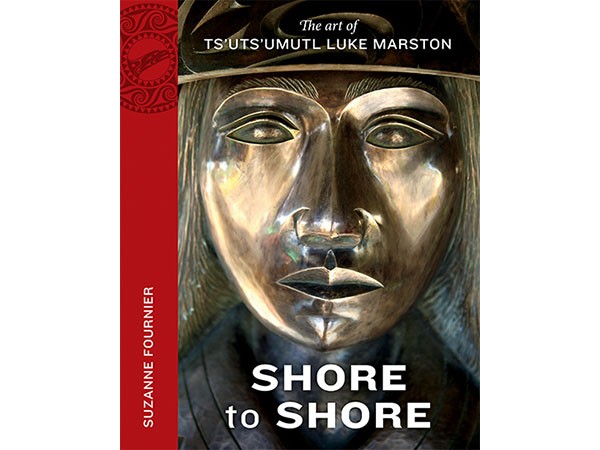
Author: Suzanne Fournier (Harbour Publishing, 2014)
To grow up in a country that is so rich with First Nation’s culture is truly rewarding. Anyone who has walked through Vancouver’s Stanley Park has stopped in awe to admire the totems that dot the grass. And it is not just in the park that we are graced with these historic pieces of art. We are lucky enough to see them in many different places throughout our cities nationally, from rich and beautiful museums to graffiti beautifying an otherwise ordinary underpass.
First Nations art is so ingrained in us from so early in our lives, that one wonders if we take for granted just how lucky we are to have these works still being created today? Journalist Suzanne Fournier followed this idea and weaves through a story that follows Ts’uts’umutl Luke Marston over his artistic career up to one of the crowning achievements of his life: a sculpture entitled Shore to Shore located in Stanley Park.
The book follows a fairly standard biography style, with an introduction leading into chapters that successively take us through the life of Marston and his work. The book centers around Marston, a Coast Salish artist by origin, and his development. Almost every page is adorned with a beautiful photograph of some sort, the majority being works of art by either Luke or his father (in the earlier parts of the book).
As the book progresses, we move through chapters that describe Luke working on his Shore to Shore project, a structure which shows three historic figures from Coastal British Columbia – one of them being Joe Silvey, Marston’s great-great-grandfather and one of the leading pioneers of British Columbia. There is a part of the book where Marston is in Red Deer, Alberta, putting together the final touches on the brass mold of his relative where an amazing photo is captured. Marston is looking into the eyes of his great-great-grandfather’s life-sized, bronze statue and there is some feeling there that seems much bigger than a sculptor and his work. It is a feeling captured by Fournier, to quote Marston himself: “To see your own work emerge like that, in another medium, it was everything I’d dreamed of.”
Also within these pages are the stories of funding (or lack thereof) that pushed Marston to the brink when working on this project. He had invested $150,000 of his own money and, because of the schedule to get the sculpture done, was unable to produce many new works to sell as jewelry or other small sculptures. By his side the whole time was his wife, Stacy Miller, who was his rock and pushed him to continue working on Shore to Shore.
The book then dives in to some of Marston’s other sculptural work as a bit of an aside, and there are many beautiful pieces that are on display through the pages. My favourite is a piece titled “First Woman” and it is a mask which combines modern and First Nations art to create a face that appears to almost be on fire. The edges are smooth, the sculpture is profound, and it was a huge hit when it was displayed at the Vancouver’s Inuit Gallery in 2009.
We follow Luke as he travels back to Portugal where his family originated two lifetimes ago, and eventually comes back to the West Coast, for the completion of his Shore to Shore project. The most amazing part about this book (beyond the stunning imagery) is the journey that Fournier weaves for the readers. It was as if she knew that while the pictures could stand on their own….that if her words were to have lasting meaning and be more than just an aid to the pictures, she’d need to capture the essence of the work through her writing style. She did just that, creating passages in the book that strike you as strongly as the artwork itself. “The grass around Brockton Point was damp from overnight showers but by late morning, watery sunlight filtered through the big trees and in the end, the forecasted rain held off for the entire ceremony.” It is a reporting of the facts that is interspersed with creative bouts that work to bounce off the visual cues of the book, making each other stronger in the process.
While we learn about First Nations history throughout school, it seems that we take for granted its incredible history and works of art from its past. Even more so, those works being created currently in these communities. Shore to Shore: The Art of Ts’uts’umult Luke Marston is more than just a pretty book filled with works of art. It is a lesson about family, about First Nations culture, and about our heritage here in Coastal British Columbia. This book is well worth a read as it teaches us more about the amazing cultural heritage we are privy to.
***
For more information, visit the Harbour Publishing website.
**
Jeremy Senko is happily lost in the world of theoretical architecture and design. He is forever a student at heart, consistently reading, experiencing and learning about the world he inhabits. More specifically, he works as an Interior Designer in Vancouver and plays an active part in bettering the environments we live in.


